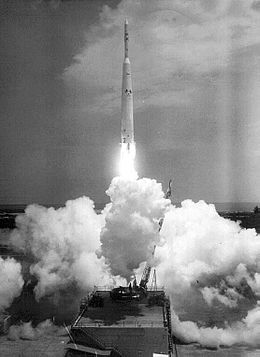Ariel 1
 Launch of Ariel 1 on a Thor-Delta rocket | |
| Mission type | Ionospheric |
|---|---|
| Operator | SERC / NASA[1] |
| Harvard designation | 1962 Omicron 1 |
| COSPAR ID | 1962-015A |
| SATCAT no. | 285 |
| Spacecraft properties | |
| Manufacturer | Goddard Space Flight Center |
| Launch mass | 62 kilograms (137 lb) |
| Start of mission | |
| Launch date | 26 April 1962, 18:00:16 (1962-04-26UTC18:00:16Z) UTC |
| Rocket | Thor DM-19 Delta |
| Launch site | Cape Canaveral LC-17A |
| End of mission | |
| Decay date | 24 May 1976 |
| Orbital parameters | |
| Reference system | Geocentric |
| Regime | Low Earth |
| Perigee | 397 kilometres (247 mi) |
| Apogee | 1,202 kilometres (747 mi) |
| Inclination | 53.8 degrees |
| Period | 100.86 minutes |
| Epoch | 14 June 1962[2] |
Ariel 1 (also known as UK-1 and S-55), was the first British satellite, and the first satellite in the Ariel programme. Its launch in 1962 made the United Kingdom the third country to operate a satellite, after the Soviet Union and the United States. It was constructed in both the UK and the United States by NASA Goddard Space Flight Center and SERC, under an agreement reached as the result of political discussions in 1959 and 1960.
Contents
1 Development
2 Launch, operation, orbit
3 See also
4 References
Development

Ariel 1 satellite, London Science Museum
In late 1959, the Science and Engineering Research Council proposed the development of Ariel 1 to NASA, following an offer made by the United States at a meeting of the Committee on Space Research to provide assistance to other countries with the development and launch of scientific spacecraft. By early the following year the two countries had decided upon terms for the programme's scope and which organisations would be responsible for which parts of the programme.
Prime Minister Harold Macmillan named the satellite after the sprite in Shakespeare's The Tempest.[3] Construction occurred at the Goddard Space Flight Center. SERC provided the experiments, conducted operations, and later analysed and interpreted the results. Six experiments were carried aboard the satellite. Five of these examined the relationship between two types of solar radiation and changes in the Earth's ionosphere. They took advantage of techniques developed in the Skylark programme.
Launch, operation, orbit

US Delta 9 rocket with UK first satellite Ariel 1, 26 April 1962
Ariel 1, the first satellite from a nation besides the United States or the Soviet Union,[4] was launched aboard an American Thor-Delta rocket from Launch Complex 17A at the Cape Canaveral Air Force Station, at 18:00:16 GMT on 26 April 1962. Ariel 1 was among several satellites inadvertently damaged or destroyed by the Starfish Prime high-altitude nuclear test on July 9, 1962, and subsequent radiation belt. It decayed from orbit on 24 April 1976.
See also
- Timeline of artificial satellites and space probes
References
^ Ariel 1 NSSDC Master Catalog. Retrieved 20 January 2015.
^ McDowell, Jonathan. "Satellite Catalog". Jonathan's Space Page. Retrieved 6 December 2013..mw-parser-output cite.citation{font-style:inherit}.mw-parser-output q{quotes:"""""""'""'"}.mw-parser-output code.cs1-code{color:inherit;background:inherit;border:inherit;padding:inherit}.mw-parser-output .cs1-lock-free a{background:url("//upload.wikimedia.org/wikipedia/commons/thumb/6/65/Lock-green.svg/9px-Lock-green.svg.png")no-repeat;background-position:right .1em center}.mw-parser-output .cs1-lock-limited a,.mw-parser-output .cs1-lock-registration a{background:url("//upload.wikimedia.org/wikipedia/commons/thumb/d/d6/Lock-gray-alt-2.svg/9px-Lock-gray-alt-2.svg.png")no-repeat;background-position:right .1em center}.mw-parser-output .cs1-lock-subscription a{background:url("//upload.wikimedia.org/wikipedia/commons/thumb/a/aa/Lock-red-alt-2.svg/9px-Lock-red-alt-2.svg.png")no-repeat;background-position:right .1em center}.mw-parser-output .cs1-subscription,.mw-parser-output .cs1-registration{color:#555}.mw-parser-output .cs1-subscription span,.mw-parser-output .cs1-registration span{border-bottom:1px dotted;cursor:help}.mw-parser-output .cs1-hidden-error{display:none;font-size:100%}.mw-parser-output .cs1-visible-error{font-size:100%}.mw-parser-output .cs1-subscription,.mw-parser-output .cs1-registration,.mw-parser-output .cs1-format{font-size:95%}.mw-parser-output .cs1-kern-left,.mw-parser-output .cs1-kern-wl-left{padding-left:0.2em}.mw-parser-output .cs1-kern-right,.mw-parser-output .cs1-kern-wl-right{padding-right:0.2em}
^ Ley, Willy (June 1964). "Anyone Else for Space?". For Your Information. Galaxy Science Fiction. pp. 110–128.
^ Ley, Willy (December 1967). "Astronautics International". For Your Information. Galaxy Science Fiction. pp. 110–120.
"Ariel 1". Space.co.uk. Archived from the original on 25 April 2012.
This article about one or more spacecraft of the United Kingdom is a stub. You can help Wikipedia by expanding it. |
This article about one or more spacecraft of the United States is a stub. You can help Wikipedia by expanding it. |